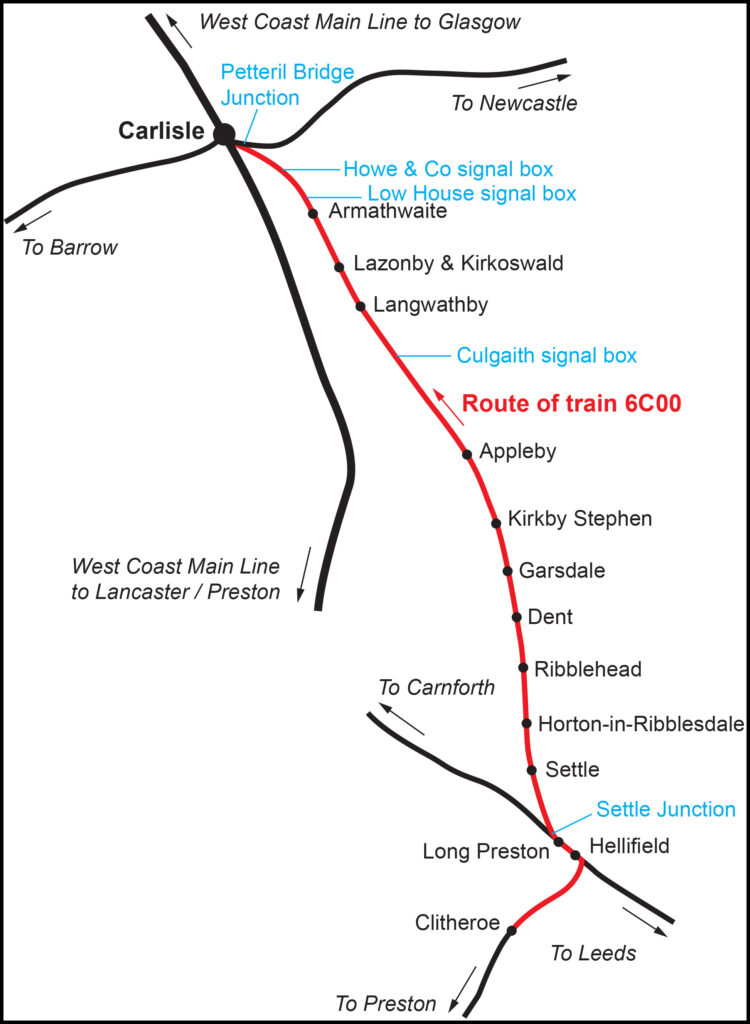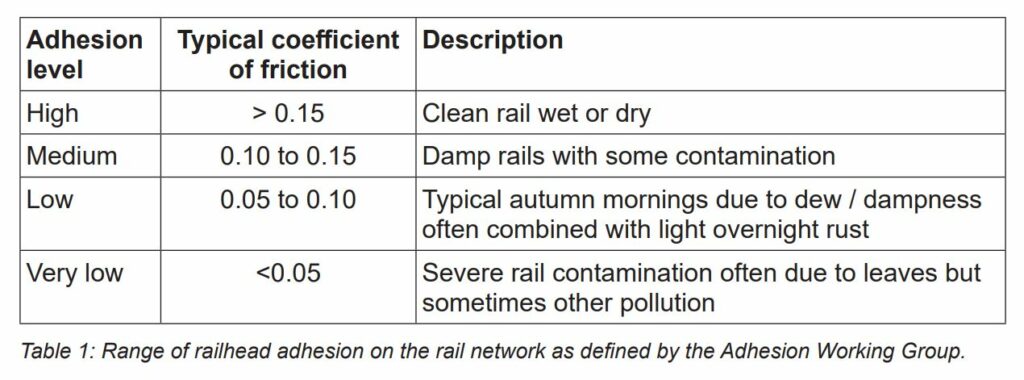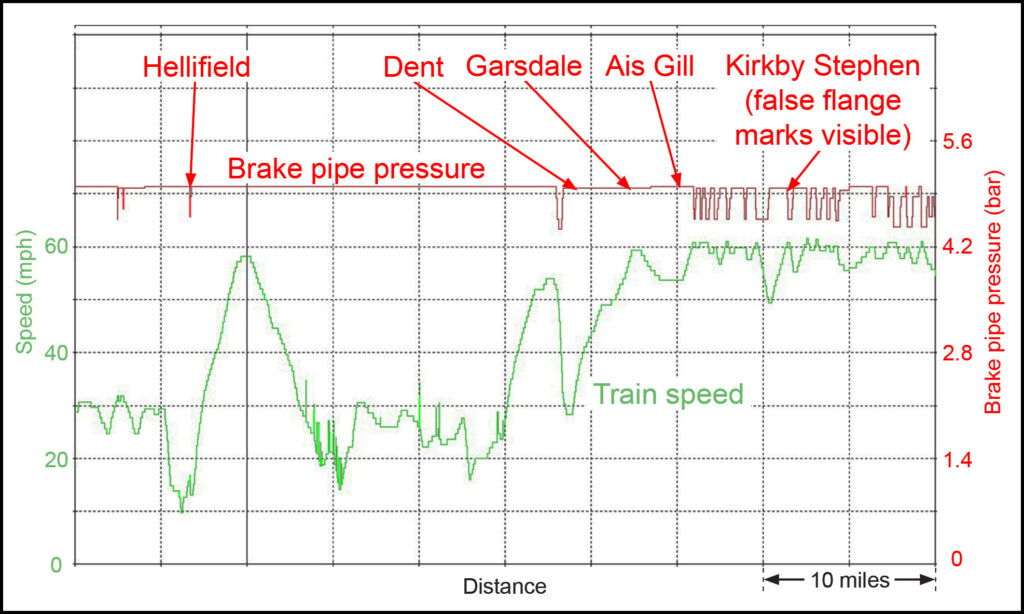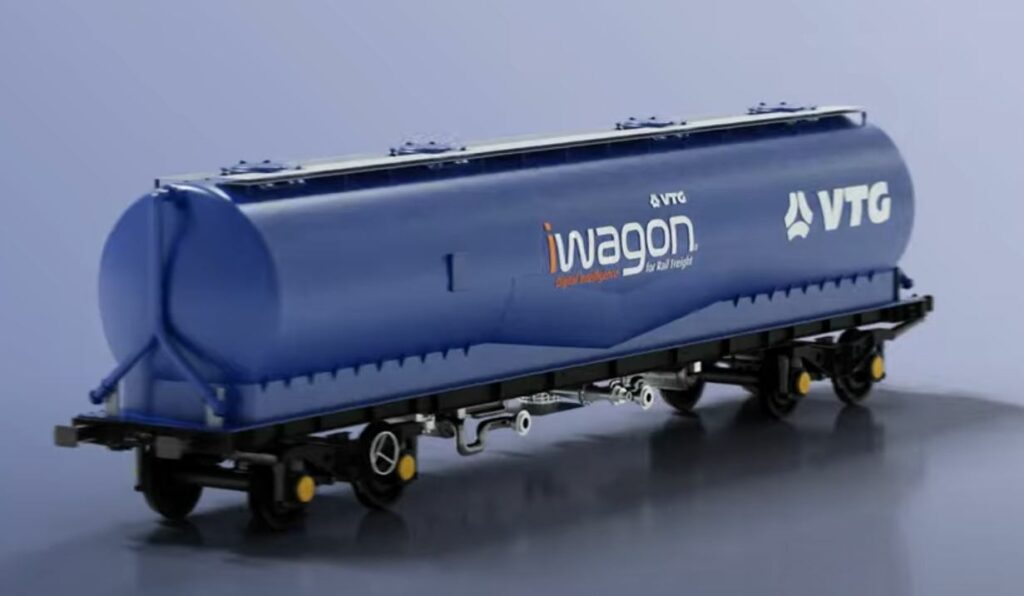On 19 October 2022, five 100-tonne cement tank wagons were derailed at Petteril Bridge Junction in Carlisle. Two of these fell off the bridge with one landing upside down in the river. No one was injured and very little cement was spilled, though the track and bridge suffered significant damage. Due to this, and the difficulties of erecting a suitable crane close enough to the derailed wagons, the lines from Carlisle to Newcastle and Settle were blocked for seven weeks.
Immediately after the derailment, the Rail Accident Investigation Branch (RAIB) advised that it was ‘almost certainly’ caused by a wheelset having large flats and, consequently, false flanges passing through switches at the junction.
This was also the cause of the derailment at Llangennech in August 2020 as Rail Engineer reported in issue 194 (Jan-Feb 2022). In this case, the wheel flats were the result of defective brakes and the RAIB report identified significant failings in wagon maintenance. Other previous freight wagon derailments had also been caused by poor wagon maintenance. Hence RAIB’s chief inspector at the time, Simon French, stressed that the safe maintenance of freight wagons has to improve. Against the background, some assumed that the Petteril Bridge derailment had also been caused by poor wagon maintenance.
Yet RAIB’s Petteril Bridge report into this accident shows that it was not caused by poor maintenance. Indeed, no-one was in any way at fault, nor was there any equipment failure. It revealed that it was caused by the train experiencing poor adhesion over an hour before it derailed.
6C00 and its journey
Freight train 6C00 consisted of a Class 66 locomotive hauling 14 JPA tank wagons each weighing about 101 tonnes, including the 80 tonnes of cement each wagon carried. These wagons had been maintained within the required periodicity and had no significant defects. 6C00 was the 17:15 from Clitheroe Castle Cement sidings to a freight yard north of Carlisle station. It had a single-pipe air brake system in which the pipe both supplies air to the wagon’s brake reservoirs and controls the braking.
The wagon brakes are applied when the brake distributor senses a reduction in air pipe pressure and then admits air from a reservoir into the brake cylinders at a pressure proportional to that of the reduction in air pipe pressure. This then forces brake blocks against the wheel treads through a system of rods and beams. The wagons have no wheel slide protection (WSP) system. Though such systems are common on passenger trains, almost all freight wagons lack the electrical supply needed to operate a WSP system.

6C00 was prepared at the Clitheroe cement terminal and joined the primarily freight-only line between Blackburn and Hellifield at 17:25. Webcam footage showed that all train wheels were rotating at this point. Eight minutes later the driver carried out a running brake test as required by the Rule Book. This applied the brake for 17 seconds and reduced the train’s speed by 11mph.
The train reached Hellifield at 18:00 after which it joined the Settle to Carlisle line which goes over the north Pennine Hills and is England’s highest railway. From Settle, 6C00 had a steep ascent for 24km at an average gradient of 1 in 107, a flatter 10km stretch along the top of the hills, followed by a 24km descent at 1 in 120 to Petteril Bridge Junction.
6C00 was travelling at close to its maximum speed of 60mph before starting its climb. Despite the driver applying maximum power, the train speed up the long gradient was around 25mph and, at one point, dropped to 17mph. The On Train Data Recorder (OTDR) showed that the locomotive was operating at its adhesion limit and so experienced frequent wheel slip. The locomotive managed this by reducing power and depositing sand on the railhead. The line also has traction gel applicators to assist trains up its steep gradients.
The train reached the line’s 356-metre summit at Ais Gill at 18:55, after which the driver made the first of many short brake applications on the long descent to Petteril Bridge Junction. By 19:53, 6C00 had slowed to 20mph as it approached the junction. As it passed over its trailing points, the leading wheelset of the ninth wagon derailed and destroyed these points so that subsequent wheelsets were derailed.
The ninth and tenth wagons then demolished the bridge parapet wall and fell into the river below. This caused the coupling and brake pipe between the fifth and sixth wagons to separate, which automatically applied the train’s brakes. The driver then advised the signaller who blocked all lines to traffic.
It was found that the derailed wheelset had flats around 290mm long and 25mm deep which resulted in a large false flange on the outside edge of the wheel. The wheelset became derailed when its false flange split the closed switch rail from its stock rail and rolled it over. The damaged points then derailed all the following wheels. The Llangennoch derailment was caused by a wheel flat 230mm long and up to 15mm deep.
Why the flat?
From an analysis of brake applications from the OTDR and false flange marks on points along the route, RAIB concluded that the wheelset stopped rotating when the driver made a 30 second, 35% full service brake application approaching the 30mph permanent speed restriction (PSR) at Dent station which is close to the line’s summit and about 86km from Petteril Bridge Junction.
The RAIB report considers that a wheelset can stop rotating due to one or more of the following:
- 1. A handbrake is left on before departure.
- 2. Brakes apply due to a faulty air brake system.
- 3. Brakes apply due to object becoming caught within the brake rigging.
- 4. An object jammed between brake rigging and wheels.
- 5. The wheelset’s axle bearings seize.
- 6. There has been a brake application in conditions of low wheel/rail adhesion.
Having systematically discounted items 1 to 5, the investigation focused on the sixth possibility.
At the time of the accident, adhesion on the Settle and Carlisle line was poor as shown by the way that the locomotive had slipping wheels as it climbed to the summit. Drivers on trains climbing to the summit from Carlise that day also reported low adhesion conditions at multiple locations. From OTDR data, gradient and train weight, RAIB was able to determine that adhesion (coefficient of friction between wheel and rail) on the climb to the summit was as low as 0.07 in one location even though sand had been applied to the rails. This compares with typical adhesion levels on a clean rail (wet or dry) of at least 0.15.

It was windy as 6C00 approached Dent, which is the highest station in England. A weather station there recorded average wind speeds of around 24 to 30 km/h, gusting to 40 km/h. With the line at this location being also particularly exposed, leaf fall in mid-October, was quite likely. This station also recorded an air temperature of 9°C, only about 1°C above the dew point. Hence it was likely that there was railhead condensation. Indeed, signallers further north noted that the rails were damp.
Dent had no record of any abnormal adhesion problems and so was not considered to have a leaf fall adhesion risk. The line here generally runs through open moorland, though there is a small group of trees on a 50-metre section of the line where 6C00 would have braked for PSR at Dent. There conditions were commensurate with low adhesion.
The RAIB investigation found that the brake application approaching Dent would have produced a retarding force of 3.6 kN per wheel. For a wheelset to slide under that level of braking, the adhesion would have to be less than 0.03.
From a study commissioned for a previous investigation, RAIB estimated that a 30-second wheelslide would produce a wheelflat about 60mm long and 1mm deep. If the wheel is to rotate once the brakes have been released, the rotational force on the wheelset has to generate enough force to overcome the 25-tonne weight on the axle for sufficient time to lift it by 1mm. The study showed that this would need a coefficient of friction greater than 0.07. Once the wheels started to slide, their flats got longer, and it became progressively more difficult for the wheel to rotate.
The report considered why only one wheelset on the train stopped rotating. It was considered possible that this wheelset was the first to experience insufficient adhesion for the brake force applied at that moment and that its slide increased adhesion for subsequent wheels.

Detecting the slide
With 6C00 running for an over an hour with a sliding wheelset, the investigation considered whether this should have been detected before the train derailed. With no engineered system in place to detect wheelsets that were not rotating, this would have required human intervention.
When the train passed Dent, it was dark. It then passed seven manual signal boxes before it derailed. The signallers there were required to observe the train’s tail lamp to confirm that it is complete and be alert to any obvious problem with the train. None of the signallers heard or saw anything amiss with the train. Although video footage at three locations showed sparks from the stopped wheelset, in some cases this was not clear until the video was enhanced.
As 6C00 reached Lazonby & Kirkoswald and left the last of the three axle counter sections controlled by Culgaith signal box, the signaller there noted that these three sections were still shown as occupied. He/she then contacted the next signaller at Low House to check if the train was complete. To do so the signaller stood on the signalbox balcony to observe the tail light but did not observe any sparking possibly because the area around the signalbox is well lit for its adjacent level crossing.
Axle counter sensors detect the passage of wheels by the distortion of a magnetic field. They are designed to detect with a compliant profile which allows flanges to be 6.5mm deeper than nominal. On the sliding wheel, the flange was about 20mm deeper than nominal. This would have been detected as non-compliant and given the signaller a fault indicator showing the track section as occupied.
The report considered whether signallers should arrange to have trains stopped and examined in the event of sequential axle counter section failures. It concludes that the Rule Book is not as clear in this respect as it refers to track circuit failures without clarifying that, as far as the Rule Book is concerned, axle counter sections are also track circuits.
The Rule Book also requires drivers to “look out from time to time to make sure that the train is following in a safe and correct way”. However, not surprisingly, the driver did not consider it safe to lean out of his cab window at 60 mph on a cold, windy night. Even if he/she had, the sliding wheelset was 150 metres from the driver who was therefore less likely to see the sparking than the signallers who saw the train passing.
It was noted that the ORR is encouraging train operators to reduce the risk of passenger fatalities from leaning out of train windows. It was therefore questioned whether this Rule Book requirement puts drivers at risk, especially when it is dark, and they cannot be sure it is safe to put their heads out of the window.

Preventing repetition
Whilst wheel slide when braking is common, it is quite rare for wheels to continue to slide after brakes have been released to the extent that a deep flat is created. Indeed many, including your writer, found it difficult to believe that this is possible on a defect-free wagon. Yet this is not the first time that this phenomenon has caused an accident. For example:
- Two rails were fractured between Pencoed and Llanharan in March 2021 after a wagon wheelset with a 185mm flat restarted rotating.
- A Rail Head Treatment Train (RHTT) at Dunkeld & Birnham was derailed then rerailed itself at the next set of points in October 2018.
- In January 2006, three broken rails were caused by wagon wheelset that acquired a 120 mm flat on long descent from Meldon Quarry and then restarted rotating.
The prevention of such accidents requires better adhesion management and /or detection of locked wheels by rail staff, trackside devices, or on-wagon sensors. These mitigations are considered below.
RAIB considers that the seasonal adhesion management regime may not fully recognise the risks to freight trains as this is driven by issues faced by passenger trains. Yet it found no evidence that the likely slide initiation location at Dent was at abnormally high risk of leaf fall. When considering the level of risk, the small clump of trees in open moorland at Dent would seem to present a trivial risk compared with, say, the large number of trees in the cutting approaching Salisbury tunnel.
Between Dent and Petteril Bridge Junction, 6C00 passed seven signalboxes at which the signallers were required to observe the train’s tail lamp and be alert to any obvious problem with the train. Whilst a signaller may notice a locked wheel, the report shows why it is not realistic to rely on signallers to detect non-rotating wheels, especially as much of the railway is controlled by power signal boxes. It also shows why it is even less realistic to rely on the driver to do so.
Trackside systems include wheel impact load detection (WILD) sites that identify vehicles with excessive dynamic loads. Although this includes those with flats on their wheels, such systems cannot detect non-rotating wheels. There are also hot axlebox detectors (HABDs) that measure radiated heat to detect failing axle bearings. In some cases, HABDs can detect the excessive temperature of non-rotating wheels though these are not generally configured to trigger alarms.
The investigation shows that sequential axle counter section failures have the potential to alert signallers of sliding wheelsets. However, this is not their design intent, and these would only detect large wheel flats on wagons already significantly at risk of derailment.
If trackside systems were to be relied upon to detect all instances of sliding wagon wheels before they caused a derailment, these would have to be placed a short distance apart throughout the rail freight network at a significant cost. In this respect it is noteworthy that the investigation could only assess the state of the wheelsets concerned six days before the derailment as this was when the wagons in 6C00 last passed over a WILD site.
On-wagon sensors
Although modern passenger trains are fitted with numerous sensors, freight wagons generally have none as they have no electrical supply. Yet recent developments show how wagon-powered sensors can prevent derailments and offer significant other business benefits.
One such initiative is the iWagon which is the result of a 10- year collaboration between Knorr-Bremse and wagon leasing company, VTG Rail UK which also owns the cement wagons derailed at Petteril Bridge Junction. Their iWagon has axle-powered generators to provide an electricity supply for wheel slide protection and various sensors which include GPS location, wheel loading, axle-lock detection, handbrake status, brake condition monitoring and the identification of harmonic frequencies to identify deteriorating components.

The iWagon can provide alerts and relevant information to the driver, Network Rail, and other stakeholders. As well as preventing derailments, these digital wagons could assist Network Rail in identifying low adhesion hot spots. Sensor data and wagon mileage can also be used to optimise maintenance to increase wagon availability. In this way, digital wagon conversions have the potential to pay for themselves.
VTG commenced a four-month trial of nine iWagons on 2 October, on Tarmac’s daily return service from its cement plant at Dunbar to its depot at Seaham in County Durham. Data from this trial will be evaluated in January ahead of the first 50 production wagons planned for 2024. This trial was intentionally planned to take place during the leaf-fall season.
Recommendations
The report’s key recommendation was, in summary, that Network Rail and the freight operating companies should work in collaboration with RSSB to review the risks faced by freight wagons during normal brake applications in foreseeably low adhesion conditions including sliding wheelsets. This review’s findings are then to be used to evaluate the processes, standards, and guidance for rail adhesion management, and produce a time-bound plan to implement the resultant changes.
The report also made two other recommendations to ensure/clarify the rules relating to sequential axle counter failures and to determine the effectiveness of the Rule Book requirement for drivers to regularly look back along their train and assess the risks of this activity.
Incidents of sliding freight wagons wheelsets caused by low adhesion are difficult to detect. Though these are fortunately quite rare, the Petteril Bridge Junction derailment shows these are potentially high-consequence events. Hence it will be interesting to see how the industry considers that this risk is best addressed from the risk assessment that RAIB has recommended.
In the long term, digital wagons will be able to trigger an alarm if a wagon had a locked or sliding wheelset. However, this is not yet a mature technology and fitting these to the UK’s 14,000 freight wagons is an expensive exercise. Yet digital technologies have been shown to have a fast rate of development and it would seem that digital wagons have real business benefits. Hence, it may not be that long before undetected non-rotating freight wagon wheels are a thing of the past. Rail Engineer will continue to report on the development of digital wagons.

